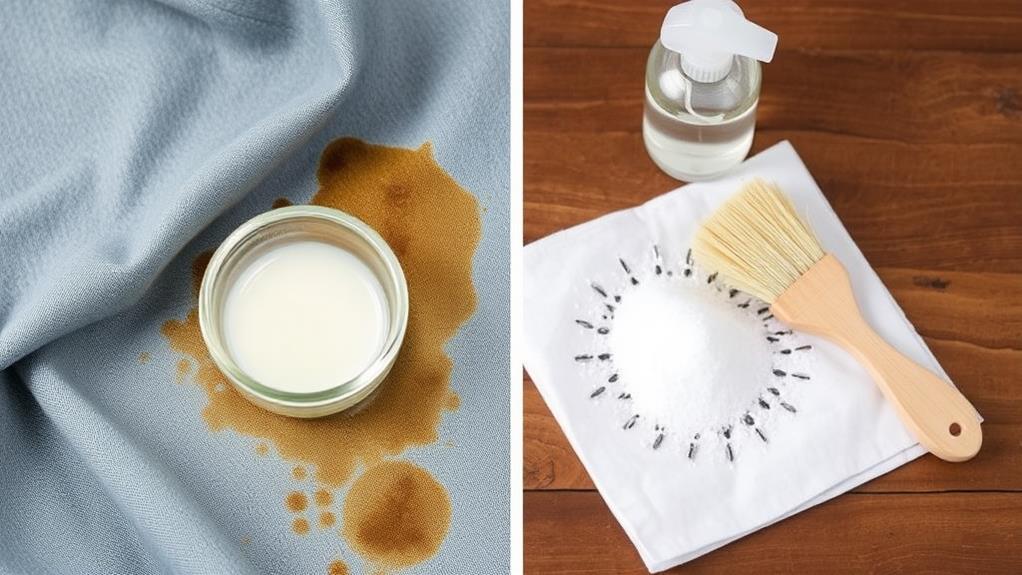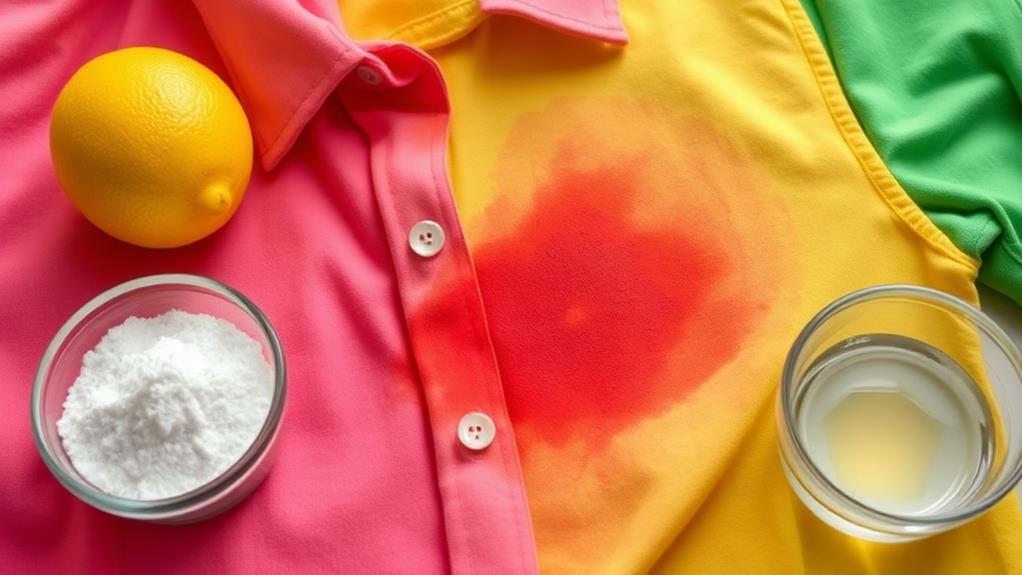To fix bleach stains on your clothes frugally, start by quickly blotting the stain with a clean white cloth to absorb excess bleach. Rinse the area with cold water to minimize damage. For removal, try a baking soda paste or a vinegar solution applied to the stain, then scrub lightly and rinse. Alternatively, dampen a cloth with rubbing alcohol and blot the area before rinsing again. If the stain persists, consider using fabric dye to restore the original color or create a new look. There's much more you can do to save your favorite garments.
Understanding Bleach Stains
Bleach stains can sneak up on you, turning your favorite clothes into a patchwork of discoloration. These stains happen when bleach interacts with fabric dyes, causing spots that are typically white or orange on colored materials.
You mightn't realize that the severity of bleach stains varies based on several factors. The concentration of bleach, how long it sits on the fabric, and the type of fabric itself all play significant roles. Natural fibers like cotton and linen are more vulnerable to damage than synthetic materials like polyester.
Utilizing an efficient expense management app can help you keep track of your laundry costs and any potential damage caused by bleach.
Quick action is essential when you notice bleach stains. The longer the bleach remains on the fabric, the more challenging it becomes to reverse the damage.
Before you assess the extent of the stain, remember that lighter fabrics might offer you a better chance of restoration than darker ones. You can also utilize common household items like vinegar, baking soda, or even commercial color removers to treat these stains effectively.
Understanding bleach stains helps you take the right steps to salvage your clothes and prevent further mishaps in the future.
Assessing the Damage
To start fixing bleach stains, you need to assess the damage first.
Check the size of the stain and identify what type of fabric you're dealing with, as this affects how it reacts to bleach.
Additionally, consider the environmental impact of your cleaning methods and opt for sustainable practices whenever possible.
Identify Stain Severity
When evaluating the damage caused by bleach stains, it's essential to carefully examine the extent of color fading and the overall impact on your garment.
Start by measuring the size and severity of the bleach spots. Larger areas of discoloration are often more challenging to fix than smaller ones, so note where the damage occurs.
Additionally, consider how long the fabric was exposed to bleach; prolonged contact usually leads to deeper stains.
To truly gauge the damage, think about these emotional triggers:
- The heartbreak of losing a favorite shirt
- The frustration of unexpected surprises in laundry
- The worry about costly replacements
- The hope of saving what you can
Determine Fabric Type
Identifying the fabric type is essential for effectively addressing bleach stains. Natural fibers like cotton and linen tend to be more susceptible to bleach damage compared to synthetic materials like polyester and nylon.
Start by checking the care label on your garment; it usually specifies the fabric type. Once you know what you're dealing with, assess the extent of the damage. Look for signs of color fading and determine if the bleach exposure was concentrated or diluted.
Keep in mind that the higher the bleach concentration and the longer it's been on the fabric, the more severe the discoloration will be.
Before you proceed with any treatment, conduct a colorfastness test on a hidden area of the garment. This helps you see how the fabric reacts to potential restoration methods.
Understanding the fabric type allows you to tailor your approach for repair effectively. Different materials may require specific dyes or treatment techniques to achieve the best results.
Evaluate Restoration Potential
Evaluating the restoration potential of bleach-stained clothing requires a careful assessment of the damage.
Start by examining the size and severity of the bleached spots. Larger areas are tougher to restore than small ones, so take note of that.
Next, consider the concentration of the bleach used; higher concentrations can lead to more significant fabric damage.
Also, think about how long the fabric was exposed to bleach—longer contact times usually mean deeper stains.
Finally, identify the fabric type, as natural fibers like cotton and linen are more vulnerable to bleach than synthetic materials.
As you assess the damage, keep these feelings in mind:
- Frustration over ruined clothes
- Sadness for lost favorites
- Hope for possible restoration
- Determination to save your wardrobe
Pre-Treatment Steps

Before you start treating that bleach stain, identify the fabric type of your garment since different materials react differently.
To avoid further damage, consider utilizing a specific custom reminders feature from financial management apps that can help you keep track of your clothing care needs.
Begin by gently blotting the stain with a white cloth to absorb excess bleach, then rinse the area with cold water to push out the bleach and minimize damage.
These pre-treatment steps are essential for effective stain removal.
Identify Fabric Type
To tackle bleach stains effectively, start by determining the fabric type of your garment, since natural fibers like cotton and linen are more prone to damage than synthetic materials such as polyester and nylon. Knowing your fabric will help you decide on the best approach to treat the bleach stain without causing further harm.
Here are some emotions you might feel when dealing with bleach stains:
- Frustration over unexpected damage
- Disappointment in a favorite garment
- Anxiety about how to fix it
- Hope for a successful repair
Once you've identified the fabric, perform a colorfastness test by applying a small amount of water or cleaning solution to a hidden area. This will help you check if the color bleeds or fades.
If the fabric holds up, you can proceed with care. Gently blot the bleach stain with a white cloth or paper towel to avoid spreading it, and rinse the stained area with cold water from the back to push the bleach out.
Blotting Technique Importance
When a bleach stain occurs, using the blotting technique is essential for minimizing damage to your fabric. This method involves gently pressing a clean white cloth or paper towel against the stained area to absorb excess bleach.
You need to act quickly; the sooner you blot, the less likely the bleach will penetrate deeper into the fibers.
Always use a clean, white cloth or paper towel to avoid transferring colors or causing additional stains.
It's important to blot from the outside of the stain toward the center. This approach helps you minimize the risk of enlarging the affected area and contains the damage.
Rinse With Cold Water
After you've blotted the bleach stain, rinsing with cold water is the next significant step. This quick action helps dilute and remove any remaining bleach from the fabric, which is essential for minimizing further damage and discoloration.
Always rinse the stained area from the back of the fabric; this pushes the bleach out instead of spreading it deeper into the fibers.
As you rinse, use a white cloth or paper towel to blot the area, preventing the stain from expanding to unaffected areas.
Remember, cold water is key here—hot water can set the bleach stains, making them almost impossible to remove. The sooner you act, the better your chances of salvaging your clothing.
- Feel the relief of taking immediate action!
- Save your favorite garment from permanent damage!
- Experience the satisfaction of a job well done!
- Keep your wardrobe looking fresh and vibrant!
Methods for Removing Stains
Bleach stains can be a frustrating challenge, but several effective methods can help you tackle them. Start by pre-treating the stain: blot it with a white cloth and rinse it with cold water from the back of the fabric to push the stain out. This step is essential before applying any removal techniques.
To avoid financial pitfalls related to laundry mishaps, consider using bill tracking tools to manage your expenses efficiently.
One effective method involves making a baking soda paste. Combine baking soda and water to form a thick paste, then apply it to the bleach stain. Gently scrub the area to lift some of the discoloration.
Another option is to create a vinegar solution. Mix equal parts of water and white vinegar, apply it to the stain, and blot gently. This can help lift the bleach damage.
If the stain persists, consider dyeing the fabric. Using RIT dye, mix it with hot water, salt, and detergent. This method might require multiple applications to achieve the desired color restoration.
Lastly, if the stains are extensive or stubborn, don't hesitate to seek professional help. A cleaning service specializing in stain removal can provide guaranteed results for your beloved garments.
Using Household Items

To tackle bleach stains using items you likely already have at home, consider common household ingredients that can help restore your fabric. Not only are these solutions cost-effective, but they also promote sustainable and ethical shopping by utilizing what you already possess instead of purchasing new products.
You'll find that simple solutions often yield impressive results without breaking the bank.
- Baking soda and water paste
- White vinegar and water mixture
- Rubbing alcohol
- Carpet dye
Start with the baking soda and water paste. Mix equal parts to create a thick paste, apply it to the stained area, and scrub lightly. This method can help lift those pesky bleach marks.
Alternatively, combine equal parts white vinegar and water, then gently blot the stain with a cloth soaked in this mixture.
For stubborn stains, dampen a cloth with rubbing alcohol and blot the affected area before rinsing with cold water. This can minimize the bleach discoloration.
If you're looking for a more permanent fix, consider using carpet dye matched to the original color to fully restore your fabric's appearance.
Seeking Professional Help
When home remedies fall short and your bleach stains remain stubborn, seeking professional help can be the best course of action. Persistent stains that refuse to budge or seem to worsen over time often require the expertise of professional cleaning services.
These professionals have access to specialized equipment and commercial-grade products designed to effectively treat bleach damage, far surpassing typical household solutions. Additionally, confirming that your payment processes are efficient through clear payment terms can help you manage any costs associated with professional cleaning more effectively.
If you're dealing with high-value garments—whether their worth is monetary or sentimental—it's wise to entrust them to a professional. They'll guarantee that your cherished items receive the best care possible, minimizing the risk of further damage.
Delicate fabrics, like silk or wool, especially benefit from professional attention, as aggressive home treatments can complicate the problem.
Moreover, while the cost of professional cleaning may seem intimidating, it can actually be a cost-effective alternative to replacing stained items. Often, the outcomes for restoration are considerably better, allowing you to salvage your favorite pieces.
Conclusion
In the battle against bleach stains, you're not just a victim; you're the hero of your wardrobe! With a little creativity and resourcefulness, you can breathe new life into your favorite clothes, turning mishaps into masterpieces. Whether you're whipping up a DIY remedy or calling in the pros, remember that every stain tells a story. So roll up your sleeves, embrace the challenge, and transform those bleached blunders into fashion statements that shine bright!



